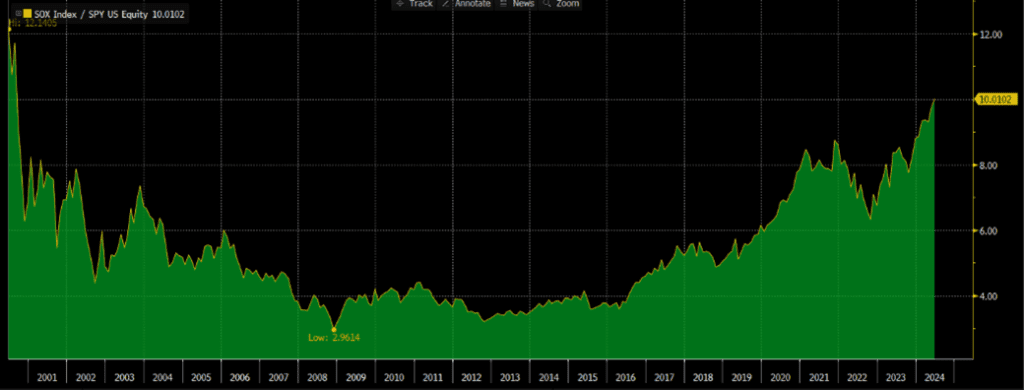AMI’s Investment Team discusses the impact of Artificial Intelligence on the markets and society at large.
Over the past year or so, the financial markets have been captivated by the potential of Artificial Intelligence (AI), sparking significant increases in the valuations of select companies and prompting extensive discussion (and hype) on AI’s capabilities. This letter aims to provide a grounded exploration of AI’s current capabilities, its objectives, and crucially, its implications for investors.
What exactly is “AI”?
“Artificial Intelligence (AI) refers to the development of computer systems that can perform tasks requiring human-like intelligence, such as speech recognition, decision-making, and problem-solving. AI has the potential to bring numerous benefits to society. It can enhance efficiency and productivity across various sectors, including healthcare, transportation, finance, and entertainment. AI-powered technologies enable faster and more accurate data analysis, leading to improved diagnostics, personalized medicine, and optimized treatment plans in healthcare. In transportation, AI can enhance autonomous driving systems, reducing accidents and congestion. Moreover, AI-driven algorithms can streamline financial transactions, detect fraud, and provide personalized recommendations.
The latest craze surrounding AI lies in generative AI, which enables machines to create original content such as art, music, and writing. This capability has sparked excitement as it opens up new creative possibilities and challenges the notion of human creativity. Generative AI has the potential to revolutionize various creative industries, offering new tools for artists, musicians, and writers to explore and innovate. It also fosters collaboration between humans and machines, pushing the boundaries of what is possible. This combination of creativity and collaboration has captured the imagination of many and has the potential to redefine artistic expression in the future.”For those that have read this far, the above 2 paragraphs were written entirely by ChatGPT, one of the more well-known text-based generative AI systems from the AI research lab OpenAI. As you can see by what was written above, a computer was able to generate two well-written paragraphs from a very simple prompt:

This capability is now being used by corporations worldwide to make their products and services better. Recently, Apple (AMI Large Cap Growth holding) announced that it will be collaborating with OpenAI and ChatGPT to allow for some of this functionality (and much more) on its iPhones. This will only help to proliferate the use of AI among consumers.
Essentially AI can learn or “be trained” on any large data set and then be able to produce insights using a text-based, non-technical prompt. For example, Adobe (AMI Large Cap Growth holding) recently announced how it is using generative AI to allow users of its popular Photoshop software to create images just by using a text prompt like the one above. Adobe has massive amounts of images that would take humans years to review each one. The company’s software can use AI to instantly consume that data and be able to allow a user to generate a completely new image. This will help expand the user base beyond trained graphic design professionals, which should help the company’s growth. Salesforce (AMI Large Cap Growth holding) is using AI to consume all the data about a particular customer (and other similar customers) and give a salesperson auto-generated material to send to that client which is based on their past actions. Additionally, AI continuously learns, so that as more data is made available, the resulting output becomes more relevant and potentially better organized.
Below is an example of how any user can create any image using a simple text prompt. This was created using Microsoft’s (AMI Large Cap Growth holding) Image Creator which is powered by DALL-E, the AI image creator developed by OpenAI, the company that produced the text creation app ChatGPT.
Using this prompt:

This image was generated in seconds:

Tech security company Palo Alto Networks (AMI Large Cap Growth holding) is using AI to better predict that a certain activity on a corporate network is indeed malicious, allowing a company to take steps to block it. The goal for Palo Alto, Salesforce, and Adobe is to use AI to make the product better for their customers and potentially charge those customers for the additional value they receive. Soon, having AI embedded in a product or service will become table stakes for companies. Not using AI may be perceived as a deficiency.
Generative AI isn’t only limited to technology-related companies. Major pharmaceutical companies have discussed how AI can be used to better formulate new drugs. Manufacturers can use AI to better design new parts or machines that might have taken several engineers a long time to do. Within the consumer space, AI is helping companies use data to improve R&D efficiency and marketing efforts.
These efficiency gains AI will enable are not to be overlooked. An April 2023 report by Goldman Sachs estimated that AI could raise global GDP by 7% primarily due to AI enabling workers to become more productive through automation. So, while many companies using AI to improve productivity should benefit, the enabling technologies should also be big winners.
Hype or not?
Currently, any company who merely mentions AI is seeing its stock price benefit as investors get excited about its potential. As a result, valuations have risen significantly before we’ve seen any measurable results. While this is reminiscent of companies in the early 2000s who added “.com” to their name, this AI boom has a major distinction. The vast majority of companies deploying AI are profitable and have successful products already in the marketplace. At least for now, AI is being used as a way to enhance the product or service in order to improve the efficiency and productivity of the end user. It will take some time to see who is deserving of a higher valuation.
Key to the advancement of AI has been Nvidia, whose stock price has more than doubled this year as companies rush to secure microprocessors essential for training models and generating useful outputs. A semiconductor gold rush is underway as firms invest in building servers and data farms to develop AI products and services. This trend mirrors the tech boom of the 1990s when billions were spent on Cisco routers and fiber optics infrastructure.
Our belief is that the ultimate winners will be companies that create compelling applications and products for end users. At AMI, our strategy focuses on companies with extensive data and customer bases poised to generate long-term value from AI. While enablers like Nvidia are currently reaping benefits, the semiconductor industry is historically cyclical, often favoring short-term gains over sustained profitability at the application layer. This pattern is evident in the contrasting performances of companies like Amazon and Google, both AMI Large Cap Growth holdings, whose shares have surged over 9,000% and 8,000%, respectively, since the early 2000s. In comparison, early enablers such as Cisco and Intel failed to sustain their initial gains. The rapid rise in the shares of hardware enablers is evident in the chart below, which shows the ratio of the Semiconductor Index (SOX) to the S&P 500 index (SPY) now reaching levels last seen during the dot-com bubble. While recent reversion has occurred in the past week, the resurgence raises concerns of potential overvaluation, suggesting that the rapid price escalation among these hardware vendors may have outpaced underlying fundamentals. Nvidia alone has accounted for more than 30% of the year-to-date gain in the S&P 500.

Source: AMI, Bloomberg (6/30/00 – 6/11/24)
Moreover, we anticipate ongoing benefits from recurring, software-based enabling technologies. Microsoft (AMI Large Cap growth holding) invested in OpenAI which powers ChatGPT which composed the intro paragraphs above and the DALL-E image referenced earlier. Google has its own generative AI software, named Gemini. These companies are using AI to improve search and other products (like Microsoft Office’s Co-Pilot). Synopsys (AMI Large Cap Growth holding) is a software company that is required to design the semiconductors sold by Nvidia and others. Notably, both Google and Apple have reportedly been working on their own microprocessors, reducing the reliance on a single vendor like Nvidia.
What does it mean for investors?
There will be winners and losers in AI and the early gold rush has so far been exciting to witness. Currently, the fear of missing out is leading companies to spend small fortunes on hardware but now they need to figure out what to do with it.
Ultimately, the substantial capital being poured into these enabling technologies must translate into tangible returns for shareholders, or risk facing scrutiny. Investors are increasingly discerning between companies merely spending capital and discussing AI, versus those effectively developing and marketing products or services that deliver actual value.
In its most recent quarterly report, Adobe noted that its AI assistant Firefly has generated over 9 billion images. At its recent developer conference, Apple announced new software that will use AI to enhance the functionality of its iPhones, potentially driving customers to upgrade their phones. It is tangible use cases like these that we believe will lead to longer-term outperformance and benefit from AI. At AMI, we are actively seeking investments in companies that demonstrate clear customer use cases, which not only attract users but also have potential monetization opportunities.
“In conclusion, the transformative power of AI promises to revolutionize industries, enhance efficiency, improve lives, and unlock unprecedented levels of innovation. Embracing AI opens doors to a brighter future for all.”
Yes, that last paragraph was also written by a machine. Apparently, AI thinks very highly of itself.
Important Disclosures
This communication is prepared and distributed by AMI Asset Management (AMI), an SEC registered investment adviser (registration does not imply a certain level of skill or training). The information contained herein, and the opinions expressed are those of AMI as of the date of writing, prepared solely for general informational and discussion purposes. The information contained in this communication has been compiled by AMI from sources believed to be reliable; however, AMI does not make any representation as to their accuracy, completeness or correctness and does not accept liability for any loss arising from the use hereof. Such information and opinions are subject to change without notice due to changes in market or economic conditions and may not necessarily come to pass. References to specific securities are not intended as recommendations of said securities. The reader should not assume that any investments in securities, sectors and markets identified or described were or will be profitable. Investing entails risks, including possible loss of principal. Past performance is not a guide to future performance and future returns are not guaranteed.
